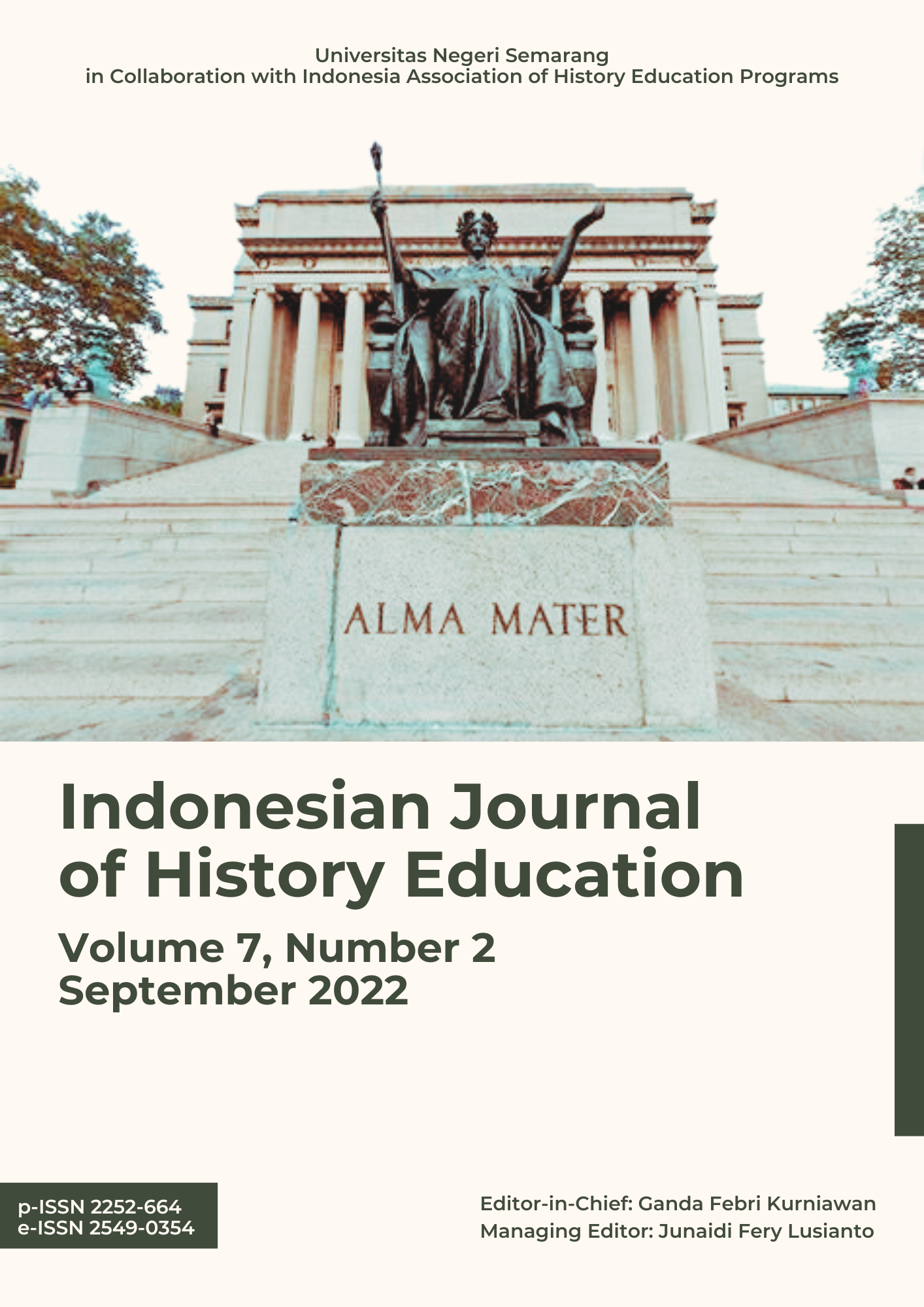Development of Indonesian History-Based Learning Media Videoscribe Material on the Islamic Kingdom in Java for Class X at SMA Negeri 3 Salatiga
Abstract
The purpose of this research is (1) To analyze the media needs of Indonesian history, (2) to know the development of Indonesian history learning media-based videoscribe Demak kingdom material, (3) to know the media feasibility of Indonesian history study-based Videoscribe material of Islamic kingdom in Java sub material of Demak Kingdom given validation results conducted by material expert and media expert as well as teacher and student assessment. The method used in this research is research and development with the ADDIE model (Analysis, Design, Development, Implementation, Evaluation). The results of this research show (1) That the learning media used by the history teacher of SMA Negeri 3 Salatiga Only used PowerPoint, picture video taken from the Internet, and a monotonous learning model resulted in subjects.
Indonesia's history has become dull and less attractive, requiring more interesting learning media. (2) The development of Indonesian history Learning media Demak Kingdom material is made using the Sparkol Videoscribe software, which is based on media scripts and narratives (3) Based on the feasibility rate of material expert validation, media experts and learning experts respectively with a percentage yield of 88.55%, 94.65%, and 93.75%. And student assessment results of 86.5%. Thus, this media should be used to study Islamic kingdom material in Java, the Demak Kingdom's sub-material.
References
Akbar, M. R., Hakim, A. R., & Haris, A. (2020). Pelatihan Pembuatan Media Pembelajaran Video Dengan Videoscribe Untuk Mengoptimalisasi Pembelajaran Berbasis 4.0. Darmabakti: Jurnal Pengabdian dan Pemberdayaan Masyarakat, 1(2), 51-57.
Al Munawarah, R. (2019). Sparkol videoscribe sebagai media pembelajaran. Inspiratif Pendidikan, 8(2), 430-437.
Aldoobie, N. (2015). ADDIE Model. Dalam American International Journal of Contemporary Research. Vol 5. No. 6. Hal. 68–72.
Arsyad, A. (2009). Media Pembelajaran. Jakarta: PT Raja Grafindo Persada.
Atmaja, H. Tri. (2019). Pelatihan dan Pendampingan Pembuatan dan Pemanfaatan Media Audio-Visual Interaktif dalam Pembelajaran Sejarah yang Berbasis pada Konservasi Kearifan Lokal Bagi MGMP Sejarah Kabupaten Banjarnegara. Dalam Jurnal Panjar. Vol. 1. No.2. Hal. 131–140.
Atno. (2011). Efektivitas Media CD Interaktif dan Media VCD Terhadap Hasil Belajar Sejarah Siswa SMA Negeri di Banjarnegara Ditinjau Dari Tingkat Motivasi Belajar. Dalam Indonesian Journal of History Education. Vol. 21. No. 2. Hal. 213–225.
Dellyardianzah. (2017). Penggunaan Media Pembelajaran Berbasis Videoscribe untuk Meningkatkan Hasil Belajar Siswa pada Mata Pelajaran Ekonomi. Dalam Jurnal Universitas Tanjung Pura: Pendidikan dan Pembelajaran. Vol. 6. No. 10. Hal. 1–10.
Fadillah, A., & Bilda, W. (2019). Pengembangan video pembelajaran berbantuan aplikasi sparkoll videoscribe. Jurnal Gantang, 4(2), 177-182.
L.R. Gay. (2012). Educational Research Competencies for Analysis and Applications. Tenth Edition. United States of America: Library of Congress Cataloging-in-Publication Data.
Munawar, A., & Suryadi, A. (2019). Pengembangan Media Pembelajaran Sejarah Indonesia Berbasis Videoscribe Materi Kerajaan Islam Di Jawa Kelas X Tahun Ajaran 2018/2019 Di SMA Negeri 3 Salatiga. Indonesian Journal of History Education, 7(2), 174-184.
Pamungkas, A. S., Ihsanudin, I., Novaliyosi, N., & Yandari, I. A. V. (2018). Video pembelajaran berbasis sparkol videoscribe: Inovasi pada perkuliahan sejarah matematika. Prima: Jurnal Pendidikan Matematika, 2(2), 127-135.
Pradnyana, Bagus Mertha. (2014). Apa itu Videoscribe. http://tirtamedia.co.id/ 2014/05/07/ apa-itu-videoscribe. diakses 1 Februari 2019.
Prastyo, G. A. (2020). Pengembangan media pembelajaran sejarah kebudayaaan Islam (SKI) berbasis videoscribe pada kelas IV Madrasah Ibtidayah Al-Hikmah Kota Blitar (Doctoral dissertation, Universitas Islam Negeri Maulana Malik Ibrahim).
Prensky, M. (2001). Digital Natives, Digital Immigrant. Dalam On the Horizon MCB University Press. Vol. 9 No.5. Hal. 1–6.
Setyosari, H. (2010). Metode Penelitian Pendidikan dan Pengembangan. Jakarta: Kencana.
Silmi, M. Q., & Rachmadyanti, P. (2018). Pengembangan media pembelajaran video animasi berbasis sparkol videoscribe tentang persiapan kemerdekaan RI SD kelas V (Doctoral dissertation, State University of Surabaya).
Sugiyono. (2016). Metode Penelitian Pendidikan Pendekatan Kuantitatif, Kualitatif, dan R&D. Bandung: Alfabeta.
Suryadi, Andy dan Andi Amirudin. (2016). Keragaman Media dan Metode Pembelajaran dalam Pembelajaran Sejarah Kurikulum 2013 pada Tiga SMA Negeri di Kabupaten Brebes Tahun Ajaran 2015/2016. Dalam Indonesian Journal of History Education. Vol. 4. No. 2. Hlm. 7-13.
Tanjung, S. (2015). Pengaruh Media Pembelajaran dan Gaya Kognitif Terhadap Hasil Belajar Sejarah. Dalam Paramita Historical Studies Journal. Vol.25. No. 2. Hlm. 261–271.
Trianto. (2010). Model Pembelajaran Terpadu. Jakarta: Bumi Aksara.
Usman, Basyirudin A. (2002). Media Pembelajaran. Jakarta: Ciputat Press.
Utomo, C. Budi. (2015). Model Pengembangan Perangkat Pembelajaran Sejarah Berorientasi Metakognitif Jenjang SMA. Dalam Paramita Historical Studies Journal. Vol. 25. No. 1. Hal. 135–144.
Peraturan Pemerintah
Permendikbud No. 22 tahun 2016 Tentang Standar Proses Pendidikan Dasar dan
Menengah
Copyright (c) 2022 Indonesian Journal of History Education

This work is licensed under a Creative Commons Attribution 4.0 International License.
Copyright Notice
An author who publishes in the Jurnal Indonesian Journal of History Education agrees to the following terms:
- Author retains the copyright and grants the journal the right of first publication of the work simultaneously licensed under the Creative Commons Attribution-ShareAlike 4.0 License that allows others to share the work with an acknowledgement of the work's authorship and initial publication in this journal
- Author is able to enter into separate, additional contractual arrangements for the non-exclusive distribution of the journal's published version of the work (e.g., post it to an institutional repository or publish it in a book) with the acknowledgement of its initial publication in this journal.
- Author is permitted and encouraged to post his/her work online (e.g., in institutional repositories or on their website) prior to and during the submission process, as it can lead to productive exchanges, as well as earlier and greater citation of the published work (See The Effect of Open Access).
Read more about the Creative Commons Attribution-ShareAlike 4.0 Licence here: https://creativecommons.org/licenses/by-sa/4.0/.




